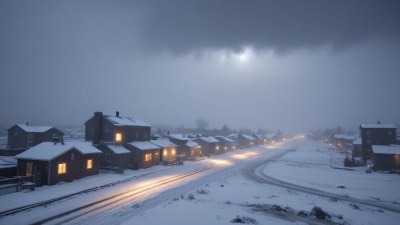Summer Blackouts: When the Grid Can't Handle the Heat
Explore the causes and impacts of summer blackouts as power grids struggle under extreme heat and increased demand.

As summer temperatures soar, the integrity of power grids across many regions faces a severe test. The demand for electricity spikes dramatically due to the widespread use of air conditioning and cooling systems, often pushing infrastructure to its limits. This surge in electricity consumption can lead to summer blackouts, a phenomenon where the power grid fails to meet demand, resulting in outages that affect millions.
Understanding the intricacies behind summer blackouts involves examining the relationship between weather, infrastructure, and energy consumption patterns. These blackouts are not only inconvenient but pose serious risks to health, safety, and economic productivity. With climate change causing more frequent and intense heatwaves, the reliability of electrical grids becomes a growing concern for communities worldwide.
The Mechanics of Power Grids under Stress
Power grids are complex systems designed to generate, transmit, and distribute electricity from producers to consumers. They rely on a delicate balance between supply and demand. In summer, extreme heat causes a sharp increase in electricity demand, largely from air conditioning usage during daytime highs. When the demand nears or exceeds the grid's capacity, operators may initiate controlled blackouts to prevent a total system collapse.
Generation plants, transmission lines, transformers, and distribution networks all experience increased strain during heatwaves. Transmission lines can sag due to high temperatures, increasing the risk of faults. Additionally, power plants—especially those reliant on water for cooling—may face operational challenges during droughts compounded by heat, reducing their output.
Why Does Heat Increase Electricity Demand?
The primary driver for increased electricity demand in summer is temperature-driven cooling. Air conditioners, fans, refrigerators, and other cooling appliances consume more power as external temperatures rise. In residential and commercial buildings, maintaining comfortable indoor temperatures becomes paramount for health and productivity, significantly boosting electricity use during heatwaves.
Furthermore, heat waves often strike during peak daylight hours when solar power output is high, but this doesn’t always offset the demand spike. The need for cooling leads to simultaneous high usage which can overload local grids especially in urban areas, where population density and building density are higher.
Infrastructure Vulnerabilities in High Heat
Many power grid components are sensitive to temperature extremes. For instance, overhead transmission cables become less efficient as they heat up and sag, increasing the risk of short circuits or physical damage. Transformers and substations may overheat, reducing their capacity or causing force outages. The aging infrastructure in many regions further exacerbates these vulnerabilities, as older equipment may not be rated for the extreme conditions caused by recent climate trends.
Moreover, cooling systems within power plants are critical. Thermal power plants rely on water for cooling operations, which becomes scarce during droughts often accompanying heatwaves. Reduced water availability can force plants to lower output or shut down temporarily, limiting supply precisely when demand peaks.
The Role of Renewable Energy in Summer Blackouts
Renewables like wind and solar are integral parts of the modern grid but have limitations in extreme heat conditions. Solar panels typically lose efficiency as temperatures rise above optimal ranges, leading to less power generation during the hottest hours when demand peaks. Wind energy can be intermittent and often dips during heatwaves characterized by stable atmospheric conditions.
Energy storage solutions and grid-flexibility mechanisms are crucial to mitigate these challenges. Batteries and demand-response programs help balance supply and demand by storing excess energy and reducing loads during peak periods. However, insufficient deployment of these technologies in some areas can contribute to grid instability during summer heatwaves.
The Impact of Summer Blackouts on Society
Blackouts during summer heatwaves have profound consequences. On a human level, they pose health risks especially to vulnerable groups such as the elderly, children, and those with medical conditions relying on electrically powered equipment. Heat-related illnesses can increase during outages when cooling systems fail, particularly in densely populated urban areas.
Economically, blackouts disrupt industrial activities, commerce, and essential services. In sectors such as manufacturing, data centers, and retail, interruptions can lead to significant productivity losses. Public services including hospitals, transportation, and emergency response also face operational risks during power outages.
Socially, blackouts can exacerbate inequalities, disproportionately affecting low-income communities and neighborhoods with less robust infrastructure. These communities often have limited access to backup power solutions such as generators or air-conditioned public facilities, intensifying their vulnerability during extreme heat events.
Case Studies: Notable Summer Blackouts
Several regions worldwide have experienced significant summer blackouts linked to heatwaves and grid stress. For example, in California during the summer of 2020, extreme temperatures combined with wildfires strained the grid, leading to rolling blackouts affecting millions. The event highlighted how climate change amplifies risks to grid reliability.
Similarly, parts of Europe, including Spain and France, have faced supply challenges during heatwaves due to reduced hydropower availability and surging air conditioning use. These incidents emphasize the importance of flexible and resilient energy systems to cope with seasonal extremes.
Strategies for Mitigating Summer Blackouts
Addressing summer blackouts requires a multi-faceted approach involving infrastructure upgrades, demand management, and technology adoption. Utilities and governments are investing in grid modernization efforts such as installing advanced sensors, automating controls, and strengthening transmission networks to improve reliability.
Demand-side strategies include promoting energy efficiency, incentivizing off-peak usage, and implementing smart grid technologies allowing dynamic management of loads. Public awareness campaigns encourage consumers to reduce electricity use during peak times, which helps stabilize the grid during critical periods.
Increasing the integration of renewable energy with complementary storage systems can also provide more reliable power during peak demand. Innovations such as vehicle-to-grid technologies and decentralized generation empower consumers to become active participants in balancing supply and demand.
Policy and Regulatory Approaches
Governments play a pivotal role by setting standards and providing funding to enhance grid resilience. Policies that encourage diversification of energy sources, investment in infrastructure, and grid interconnections across regions help mitigate blackout risks. Regulatory frameworks also support adoption of clean energy and storage technologies by creating favorable market conditions.
Furthermore, emergency preparedness plans tailored for heatwave scenarios improve response capabilities. Coordinated efforts between utilities, emergency services, and communities ensure quicker restoration of power and effective communication during outages.
Looking Ahead: Preparing for a Hotter Future
Climate projections indicate rising global temperatures with more frequent and intense heatwaves. This trend challenges traditional power grid designs and operational protocols. Future-proofing the grid involves embracing innovative technologies, expanded renewable energy portfolios, and adaptive management strategies that account for climate variability.
Urban planning and building codes are also integral, requiring construction techniques that reduce heat gain and electricity demand while promoting resilience. Enhanced insulation, reflective materials, natural ventilation, and green infrastructure can help lessen the burden on the grid during the hottest months.
At the individual level, awareness and preparedness measures such as having backup power options and safeguarding vulnerable populations contribute to community resilience. Collaborative efforts at all levels—from local to global—will shape the capacity to manage summer blackouts effectively as temperatures continue to climb.
Ultimately, addressing summer blackouts is a complex challenge at the intersection of energy, climate, and societal systems. Proactive investment, innovation, and coordinated policy action are essential to ensure reliable electricity supply amidst increasingly demanding conditions and protect public health and economic stability in an increasingly hot world.











